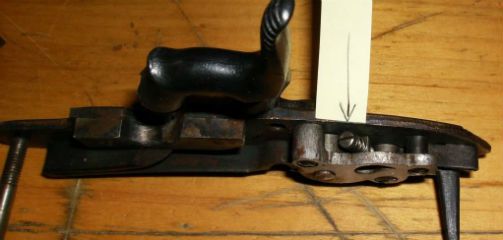The Triggers;
Now one of the problems with these older rifles is people(previous owners) think all the screws have to be Gorilla tight! It's not the case, we're dealing with an old dry wood stock here not a modern steel one.
Over tightening of the screws through the years can(and does) squish the wood (compressed) and it's damaged. Sometimes shimming and or re-bedding the trigger inlet is needed (easy).
* Leave the lock out.
* Look in that round hole inside the lock inlet and work the triggers, see those "bars" moving? Those are the trigger cams/levers.
* Pull the trigger guard(2 screws) and set it aside.
The trigger plate is held in with one screw (in back under the trigger guard) and one tang bolt.
* From the top of the rifle, remove the front tang bolt, it's long, it goes all the way through from top down to the triggers, but once it's loose from the trigger plate it'll pull out.
* Remove the screw in back of the trigger plate, grab the triggers and wiggle it out.
This is your triggers;
What you see here is the rear trigger cam in the unset position. The trouble with an older stock like I said is compression of the wood. What happens is folks over tighten that tang bolt, squishing the wood, and the trigger plate ends up too deep in the inlet,, that leaves the rear cam too high and it actually contacts that sears trigger arm of the lock(the rod that sticks out inside the lock),It shouldn't touch there, there needs to be a tiny gap so the sear arm can move freely.
* Clean and oil the triggers like you did the lock.
Everyone seems to know about the screw between the triggers adjust how far you pull the front before the rear releases when set, right(?)
But there more;
The big screw in back holding the leaf spring in adjusts how hard the leaf spring pushes on the rear trigger cam (I like it set pretty stiff), and that little screw underneath the leaf adjusts how far the leaf spring travels as it pushes the rear.
IF, you find out the rear cam is indeed too high to clear the sear arm,, you can turn that screw underneath in and the rear cam will ride a little lower.
You can go too far, the rear cam still needs to strike the sear arm with force.
What you describe in your first topic post is usually the compressed wood issue, but we did/do need to address the clean and oiled issue first.
So you got everything out, cleaned and oiled right?
The simple fix for compressed trigger inlet wood is to
shim the front of the trigger plate where that tang bolt goes in, you can use folded up paper/cardboard, tiny washers, a piece of wood from a Popsicle stick,, what ever comes to mind and you may have to in-out with trigger a few times to get it right.
Put the lock in first, and don't forget that flat spring on the front lock bolt you took out first, it faces forward, curvy part down.
Come on back if you get hung up.






